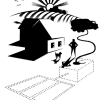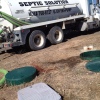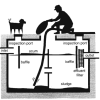Septic systems are very much like automobiles. They need periodic inspections and proper maintenance to continue working properly. Also, like automobiles, they must be operated properly and cannot be overtaxed without the owner suffering consequences such as repair or replacement bills.
Often overlooked or neglected is the fact that a septic system should have a regular check-up to prevent problems. You should have your septic system inspected every 1-2 years by a profes- sional and your tank pumped when necessary. The septic tank traps the solids in the wastewater and should be checked to determine whether or not
it is time for it to be pumped out. The inspection port should be opened and the baffles (internal slabs or tees) should be checked to ensure that they are in good condition since the last check-up (see Figure 1). If you have a septic tank effluent filter,
it should also be inspected. Effluent filters require periodic cleaning. Some filters are now equipped with alarm systems to alert the homeowner when the filter has become dirty and needs to be cleaned. Failure to keep the filter clean may result in a backup of wastewater in the home from a clogged filter. Septic systems that have mechanical parts such as a pump should be inspected at least once
a year or more frequently as recommended by
the manufacturer. The absorption field should be checked for sogginess or ponding, which indicates improper drainage, a clogged system, or excessive water use. The presence of damp or soggy areas or odors may indicate a leak in the system.
This article comes from the National Small Flows Clearinghouse. For more information about this or other NSFC products, please contact: National Small Flows Clearinghouse West Virginia University P.O. Box 6064 Morgantown, WV 26506-6064 or phone:
(800) 624-8301, (304) 293-419 www.nsfc.wvu.edu





